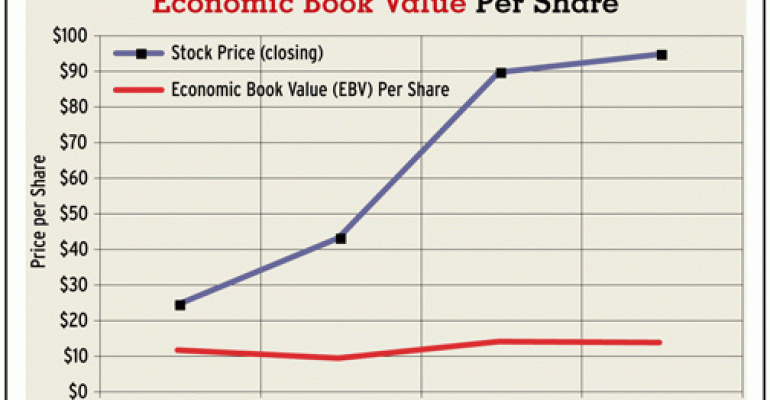Mentioned In This Article
The Euro crisis is an excellent demonstration of how long-insolvent organizations can perpetuate the poor capital allocation and spending decisions that created their insolvency. Predicting exactly when the euro finally breaks down is a challenge, to say the least.And when I write “brace” your portfolio, I mean take a net short position as I have in my portfolio.
In building your short positions, I recommend you consider VMware (Ticker: VMW), the self-described global leader in virtualization and cloud infrastructure. Whenever a general market decline is on the horizon, the best protection is shorting super-expensive stocks with very little in hard assets. In other words, the stocks that will fall the hardest are those whose cash flows are not backed by any tangible or liquid assets while their valuations are sky high. Those stocks have nothing to offer investors when the growth winds turn against them. Most of their talent/assets leave when they close the building every night.
VMware is a company with very little in hard or liquid assets, especially when compared to its market value. A quick look at their latest balance sheet reveals that intangibles at about $2.2 billion are nearly five times the value of the company’s hard assets (property, plant and equipment) at just over $500 million. The company’s largest asset is about $4 billion in cash. Not all of that would be available for equity investors though. From the $4 billion, one needs to deduct $735 million in debt (including off-balance sheet debt) and $1.4 billion in stock option liabilities. So, we are down to about $1.8 billon in cash, which is dwarfed by the company’s $39.3 billion market value.
Sophisticated readers would object to my argument so far on the grounds that that stock prices are based on future cash flows not the book value of assets or cash on the balance sheet, and I agree wholeheartedly. My point is that there is little downside protection to VMW stock in the event the European debacle causes another Lehman-like arrest in global economic activity.
Turning to future cash flows for VMW, I admit the company’s prospects are rosy. Indeed, its economic earnings have been impressive though not as strong as the accounting earnings would have you believe. However, the future cash flow growth baked into its stock price will make even the most aggressive momentum trader pause.
Specifically, VMW’s stock valuation (based on latest closing price of $94) implies 30 percent compounded annual profit growth for the next ten years. In the history of the world, I’d bet that few companies have ever achieved such growth. From 2000 to 2010, fewer than ten companies achieved such growth, and Apple (AAPL) is not one of them. Moreover, I think it is fair to say that almost no one expects to enjoy growth over the next 10 years that is as good as the first decade of this century (thought that was marred by two recessions in the US).
The takeaway is that VMW’s stock price already reflects the rosiest of expectations for future cash flows. It is priced for perfection on all levels.
Figure 1 compares VMW’s stock price to its economic book value per share, which is, put simply, the perpetuity value of the company’s after-tax cash flow. It is also known as the no-growth value of the business. The difference between the stock price and the economic book value per share of a company is the value of its future growth. Investors need to be wary of stocks that embed too much future growth and set impossibly high expectations. Figure 1 clearly shows that expectations for future cash flow growth for VMW have accelerated over the past few years.

To put Figure 1 into context, the ratio of VMW’s stock price to its economic book value is 7.2 compared to the S&P 500 at 1.8, the Russell 3000 at 2.1 and the Russell 3000 at 4.0.
VMW’s valuation has its head in the clouds.
The stock has too much downside risk compared to too little upside potential. Really, what’s next? Expectations for 15 years of 30 percent compounded annual growth? This stock is a great short in most any scenario and is especially attractive in the event of a global economic slowdown led by a recession in Europe.
I also recommend you short or sell the following ETFs and mutual funds because they allocate the most out of the 5,000-plus ETFs and mutual funds we cover to VMW. Note that each ETF/fund allocates 5 percent or more of its portfolio to VMW, and all of them except for RCKSX get a dangerous rating, according to my predictive fund rating methodology. Free copies of my reports with my predictive fund rating on the ETFs and funds are available by clicking on the name of the fund below.
Oak Associates Funds: Black Oak Emerging Technology Fund (BOGSX)
Berkshire Funds: Berkshire Focus Fund (BFOCX)
PowerShares Dynamic Networking (PXQ)
Oak Associates Funds: Rock Oak Core Growth Fund (RCKSX)
Disclosure: David Trainer am short VMW. I receive no compensation to write about any specific stock, sector or theme.
About the AuthorIncorporated in July 2002, New Constructs is an independent publisher of investment research that provides clients with consulting, advisory and research services. We specialize in quality-of-earnings, forensic accounting and discounted cash flow valuation analyses for all U.S. public companies. We translate accounting data from 10Ks into economic financial statements, i.e. NOPAT, Invested Capital, and WACC, to create economic earnings models, which are necessary to understand the true profitability and valuation of companies. Visit the Free Archive to download samples of our research. New Constructs is a BBB accredited business and a member of the Investorside Research Association.





